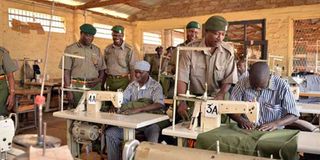Premium
Power brokers targeted schools, prisons, local authorities land

Inmates at Kamiti Maximum Security Prison in a tailoring class. The National Land Commission says the correctional institution lost 50.16 acres of its land to grabbers. PHOTO | FILE
What you need to know:
- The beneficiaries would be offered huge chunks of public land, at times running into thousands of acres, by the powers-that-be in exchange for political loyalty.
- In some situations, grabbers would secure public land at throwaway prices then arm-twist institutions such as the National Social Security Fund to buy them at market or exaggerated rates.
- The National Land Commission has revoked title deeds for 151 parcels hived off Karura Forest and directed that they revert to the original owner; the Kenya Forest Service.
- Prof Kaimenyi said Kitale Prison was the biggest victim, having lost 2,717 acres.
The revocation of thousands of title deeds has laid bare the extent to which well-connected individuals colluded with the State to grab public land.
More often than not, the beneficiaries would be offered huge chunks of public land, at times running into thousands of acres, by the powers-that-be in exchange for political loyalty.
In other cases, high ranking government officials working in cahoots with ruling party hawks would create a necessity for “resettling” squatters to hive off thousands of acres belonging to public institutions and allocate themselves and their proxies the said land.
In some of the most brazen situations, grabbers would secure public land at throwaway prices then arm-twist institutions such as the National Social Security Fund to buy them at market or exaggerated rates, raking in millions of shillings in overnight deals.
PUBLIC INSTITUTIONS
Some of the most affected public institutions included local authorities, prisons, research centres, schools, state corporations, state lodges, public playgrounds and road reserves.
The National Land Commission has revoked title deeds for 151 parcels hived off Karura Forest and directed that they revert to the original owner; the Kenya Forest Service.
According to the Ndung’u Report, the plunder of the forest took place between 1996 and 1998.
Nobel laureate Wangari Maathai and several opposition lawmakers, including James Orengo and Njehu Gatabaki, stormed the woodland on January 8, 1999, to stop more grabbing.
The daring raid drew global attention to Kenya’s grabbing menace when Prof Maathai and her group were set upon by vigilantes guarding the grabbed property and beaten senseless.
NDUNG'U REPORT
Today, only 564 hectares (1,394 acres) of the original 1,063 hectares (2,627 acres) remain, according to the Ndung’u Report.
The Prisons department has also served as a playground for grabbers, with Lands Minister Jacob Kaimenyi revealing last year that nearly 4,579.54 acres belonging to various correctional institutions had been illegally taken by private developers.
Prof Kaimenyi said Kitale Prison was the biggest victim, having lost 2,717 acres.
In Nairobi, the Remand and Allocation Prison in Industrial Area lost 36.99 acres, Nairobi West (60.91), Lang’ata Women (27.67) and Kamiti 50.16 acres.
In its latest edition of the Kenya Gazette, the commission has revoked titles for 117 parcels of land belonging to Eldoret GK Prisons.
PUBLIC UTILITIES
Among the beneficiaries of the land whose titles have now been cancelled include two former commissioners of prisons Edward Lopokoiyit and Abraham Kamakil.
Other beneficiaries of the prison land include former MPs William Morogo and Vincent M’Maitsi, businessman Sammy arap Kogo and educationists George Godia and Laban Ayiro as well as several companies.
Also not spared by grabbers were learning institutions.
NLC revoked title deeds for several city public schools, including Riruta Satellite, Lavington, North Highrise, St Michael primary schools, Eastleigh and Aquinas secondary schools, Giachuki Secondary School in Murang’a among others.
An audit commissioned by a lobby group, Shule Yangu Policy Brief in 2016, showed that land for 29,404 primary and secondary schools was at risk of being grabbed.
LEASE CERTIFICATES
The audit also revealed that 83 per cent of the institutions did not have lease certificates, making them susceptible to grabbers, while another 55 per cent had never been surveyed since their establishment many decades ago.
A further 14 per cent had reported land-grabbing and their plots contested, prompting the government to issue instructions to headteachers, boards of management and communities to erect fences to mark school boundaries.
Land belonging to the defunct local authorities in many parts of the country also fell prey to grabbers.
Thousands of plots belonging to the City Council of Nairobi and Nakuru, Eldoret, Kisumu, Kiambu and Kisii municipalities were among properties whose title deeds were revoked.
Also hard hit by land grabbing were thousands of acres of land set aside for road reserves and public utilities such as playgrounds.
SOUTHERN BYPASS
NLC revoked title deeds for 136 parcels of land on the Southern Bypass, Nairobi and reverted them to the Kenya National Highways Authority.
A report by the Kenya National Commission on Human Rights captured the extent to which State corporations were used to facilitate grabbing, especially during the Daniel arap Moi presidency.
“No doubt, the extensive networks of the Moi administration still wielded immense influence at the time.
This ensured that the commission did not get all the information it needed. Nonetheless, it was able to establish massive theft of public land,” the report noted, referring to the Ndung’u Commission.
The report said the commissioner of lands would, in some cases, even without the knowledge of the management, simply allocate parastatal land and issue title deeds to favoured individuals.
NSSF CULPRITS
“The corporation management would wake up to the fact that land had been acquired and titles issued without its knowledge or consent,” said the Ndung’u Report.
In sanitising some of the theft, a state corporation would irregularly surrender its land through a letter to the commissioner of lands alleging it no longer needed the parcel, the report adds.
Within no time, and in what was clearly choreographed, some well-connected operatives would apply to be allocated the surrendered piece, to which the commissioner of lands would promptly oblige.
“Other methods were more brazen. Some state corporations were simply run down, ending-up in receivership or liquidation.
Their land and other assets would then be sold at throwaway prices.
Such is the fate that befell the Kenya Food and Chemical Corporation Ltd,” reads the report. State agencies whose land was grabbed and dished out individuals include the Agricultural Development Corporation whose 58,000 acres was given to top government officials in the 1980s and 1990s, the Kenya Railways Corporation, the former Kenya Agricultural Research Institute whose 3,550 acres was irregularly allocated to the well-connected.
DUBIOUS HONOUR
But the dubious honour of the corporation that most facilitated this plunder goes to NSSF, according to the KNCHR report.
“Within a short period of five years (1990 to 1995), NSSF spent up to Sh30 billion purchasing developed and undeveloped plots and other land of little or no value in various parts of the country,” the report said.
Rather than protect the interest of workers, the Fund’s Trustees’ main pre-occupation became buying land in what the Ndung’u Report says were highly suspect circumstances.”
The report gives two examples to back up its argument.
“Remember the Nyayo Pioneer car? The Numerical Machining Complex was incorporated in 1994 to take over the business, property and liabilities of Nyayo Motor Corporation,” it says.
MAVOKO MUNICIPALITY
On June 24, 1994, the company was allocated 839.7 hectares in Mavoko Municipality (part of the Kenya Meat Commission holding ground) ‘for industrial research purposes’. Why the company needed so much land is unclear.”
“Within a few weeks, the then Head of Civil Service and Secretary to the Cabinet Philip Mbithi, an ex-officio director of the company, wrote to Samuel Muindi, then Managing trustee of NSSF informing him that the President had suggested that the NSSF be requested to purchase the land at market value. In February 1995, NSSF bought 136.07ha of the land at a cost of Sh268 million.”
This price was eight and a half times more than the professionally assessed value.





